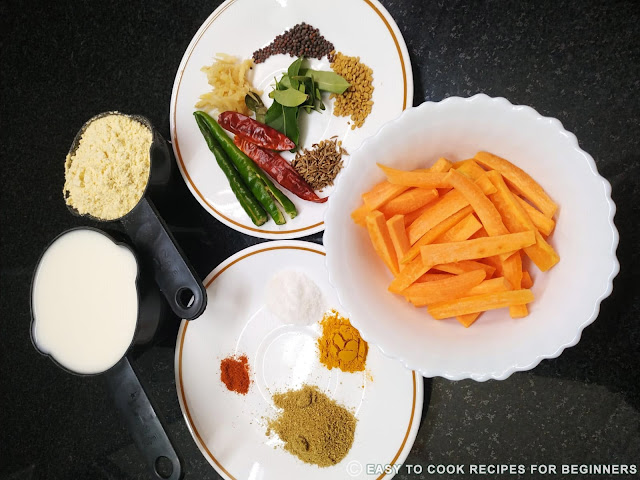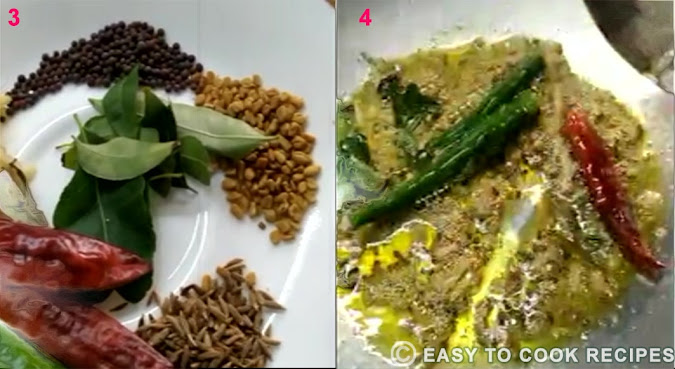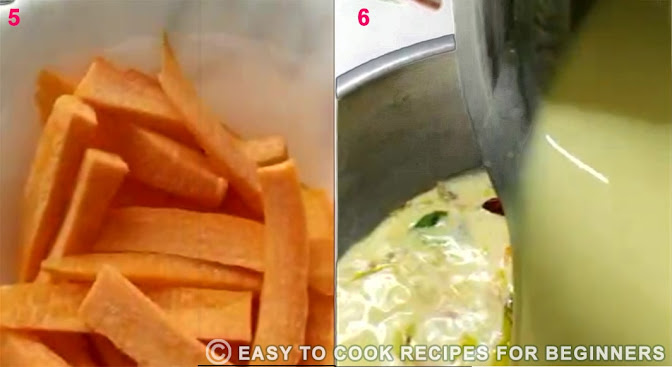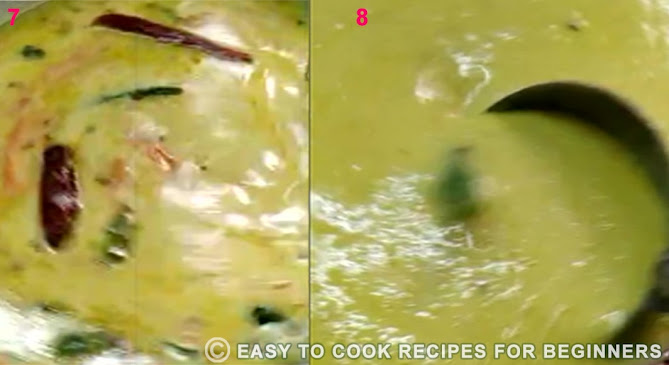Kadhi is most relished among the people of North India and Punjab called as Kadhi (not to be confused with curry), they enjoy it with rice (chawal) thus it is called “Kadhi Chawal”. A recipe which is tangy, spicy and mouth-watering is prepared with sour yogurt which gives sourness and along with batter prepared from gram flour which helps to balance the level of sourness. One has to beat the batter to a smooth consistency; this prevents formation of lumps while preparing kadhi.
The pakoras that are added to the recipe can be of any combination which
are prepared with gram flour batter which gives them golden brown color coating after they are deep fried. In my recipe I won’t be adding pakoras to
keep the recipe healthy and may deter one from making it if short of time or
wanting to avoid fried stuff. It tastes equally good even without pakoras
too and it is totally up to you to add pakoras. I will be sharing the
preparation of curry with detailed steps along with photos in coming paras to
make the process easier for you.
You can also try experimenting with this recipe along with the
ingredients by increasing or decreasing their quantity that I will be
sharing. My mother often prepares Kadhi on Thursdays in a healthy way by
excluding the deep fried pakoras and all my family members enjoy it
together with plain rice. When it’s being prepared in our home everyone
including our neighbour knows that kadhi is being prepared as the aroma
leaks out from our kitchen to the streets.
Benefits of ingredients used in Kadhi
Dahi/ Curd:
Dahi/ curd is preferred in numerous ways like lassi /chaach, which is most
common in Punjab. Chilled lassi is relished along with butter in Punjab and
the tall glasses filled till brim makes one’s mouth water. It is an
important accompaniment and a probiotic without which no meal is complete.
Dahi is added to numerous recipes which gives them a smooth texture. One
also make flavoured lassi at home like mango lassi and banana lassi. There
are variety of flavours available in the local markets that can be
enjoyed.
Besan/ Gram Flour:
An aromatic flour which is our major ingredient in our recipe. It is high
in fibre and heavier than wheat flour and keeps one fuller for longer
duration. It is high source of protein and has become famous all over the
world as a gluten free alternative. Compared to normal flour / atta it is
low in calories. You can make many recipes with besan like chilla and
sweets like besan ladoo. It
also helps to keep our bones strong. My favourite recipe prepared from
besan is halwa and ladoo.
Namak/ Salt:
Namak / salt is a very important spice without which our taste buds
wouldn’t have experienced any taste. Like other spice salt also contains
innumerable benefits. It keeps us hydrated by providing much needed sodium
and potassium to the body. It is an excellent electrolyte and helps to
prevent muscle cramping. Salt enhances the quality of sleep. Gargling with
warm salt water helps cure the disturbed throat.
Turmeric Powder:
Turmeric powder gives dal a slight golden colour. Turmeric powder is a
must have in every Indian kitchen which is known for its beneficial and
medicinal properties since ages. It is very liberally used in Ayurveda
system of medicine. I have used 1/2tsp turmeric powder.
Dhaniya / Coriander powder:
Dhaniya is also called as an aromatic herb which is loaded with vital
vitamins and minerals like B, C and K. This small spice is known to keep the
inflammation under control. They keep one active and energetic by helping in
the production of Red Blood Cells.
Whole Red chillies/ Red chilli powder:
As the name
suggests this spice makes the dish hot and spicy. One can easily
adjust it to one’s liking.
It is a great antioxidant, and aids in keeping the blood vessel free of
cholesterol deposition. It is available as a whole and in powdered form as
well. One can always powder these at home, but after taking up the
challenge of its aerosol particles attacking your nose and eyes.
Hing/ Asafoetida:
An unpleasant flavour and strong odour that keeps this infamous spice
isolated, yet it’s an essential ingredient without which many dishes are
incomplete. Known for its beneficial properties and its use in Ayurveda
for treating diseases like bronchitis.
Jeera/Cumin seeds:
A spice having antioxidant
properties which aids in preventing cardiovascular diseases by filtering
the toxins from our body. It is a good source of Potassium that boost our
immunity helping to fight the infections. Adding to an endless list of
benefits here are some extra benefits that this spice hides within itself,
it helps in curing Anaemia and keeps the hair healthy.
Mustard seeds:
Mustard has a pungent smell which is why it is used in small quantities. It
is a widely grown crop in India. Its seeds are dried and processed to
prepare edible cooking oil known as “Mustard oil/ Sarson Ka Tel” which is
widely used in Indian kitchens. Its beneficial properties are varied in
number. They contain vitamins and minerals like C, K, Potassium, Magnesium,
iron, phosphorus and sodium. They also shares common properties of spices
like antioxidant, it may help to slow down cancer.
Methi /Fenugreek seeds:
Methi / Fenugreek is another incredible spice used in Indian homes. It is used to cure various diseases like upset stomach, fever and anaemia. Waiting to unleash its benefits when consumed in form of vitamins and minerals like Vitamin C, potassium, magnesium, calcium, sodium, zinc and iron when added to the dish boost the nutritional value.
Ingredients (serve - 4 pax)
1/2 cup besan/ gram flour/ Chana dal flour
1/2 cup sliced carrots/onions / beans (optional)
1 tsp salt or to taste
1 tsp turmeric powder
2 tsp dhania powder
1/4th tsp red chilli powder or to taste
3 tbsp oil
1 litre water
For the tadka/tempering:
2 large pinches hing/ asafoetida
1/2 tsp each Jeera, mustard and methi seeds
1/2 tsp ginger
A few curry patta
2 whole red chillies
2 whole green chillies slit
Step By Step (photo wise)
Step 1
1) In a large bowl put besan and make a smooth batter by gradually adding 1 cup water. Now add the curd, salt turmeric dhaniya powder and red chilli powder and mix well. Add another three cups of water and mix well.
2) Heat 3 tablespoon oil in a heavy bottomed wide pan.
3) Add all the tempering tadka ingredients.
4) Stir till everything crackles for a minute. Stir till everything crackles for a minute.
Step 3
5) Add carrots or any other vegetables you would like to use or skip this step if you don't want to use vegetables.Stir for 30 seconds to one minute.
6) Pour the batter.
Step 4
7) Keep stirring till it starts boiling otherwise the flour will stick to the bottom of the pan.
8) Once it is simmering keep cooking for another 10 minutes stirring occasionally till desired consistency is reached.
9) Curry is ready.
10) Transfer it to serving bowl and serve piping hot.
I have tasted this curry now it's your turn. You must try it at least once. I am sure it will become among one of your favourite dishes.
Step By Step (video)
Method
1) In a large bowl put besan and make a smooth batter by gradually adding 1 cup water. Now add the curd, salt turmeric Dhaniya powder and red chilli powder and mix well.
2) Add another three cups of water and mix well.
3) Heat 3 tbsp oil in a heavy bottomed wide pan and add all the tempering tadka ingredients. Stir till everything crackles for a minute. Add carrots or any other vegetables you would like to use or skip this step if you don't want to use vegetables.
4) Stir for 30 seconds to one minute and then pour the batter. Keep stirring till it starts boiling otherwise the flour will stick to the bottom of the pan.
5) Once it is simmering keep cooking for another 10 minutes stirring
occasionally till desired consistency is reached.
6) Serve hot.
Conclusion
To sum up Kadhi is most relished among the people of North India and Punjab called by the name Kadhi (not to be confused with curry). They enjoy it with rice (chawal). It has tangy and spicy taste. To avoid lumps formation prepare a smooth batter. You can prepare Kadhi with / without pakoras. Major ingredients for Kadhi is sour curd and besan , so if you don't have sour curd you can easily prepare it by keeping some of it outside for 3-4 hours and its ready for Kadhi. Don't forget to use curry leaves as it gives unique flavour to kadhi.
If you have tried our recipe do share your feedback with us in the comments section.














0 Comments
Leave your valuable feedback please